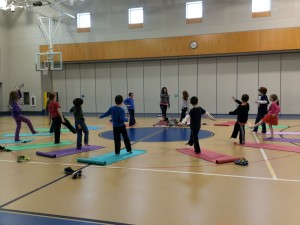 Gymnastics, swimming, dance, martial arts, basketball, soccer… There are already many choices available to parents for physical, movement-based extracurricular classes for their children. What makes yoga different? And what are the benefits for yoga for children?
Gymnastics, swimming, dance, martial arts, basketball, soccer… There are already many choices available to parents for physical, movement-based extracurricular classes for their children. What makes yoga different? And what are the benefits for yoga for children?
Our children live in a hurry-up world of busy parents, school pressures, incessant lessons, video games, malls, and competitive sports. We usually don’t think of these influences as stressful for our kids, but often they are. The bustling pace of our children’s lives can have a profound effect on their innate joy—and usually not for the better. By practicing yoga poses, children can learn how to exercise, develop confidence, and concentrate better. As yoga becomes more popular in schools through physical education classes and after-school programs, yoga’s rising popularity can be attributed to its basic stretching advantages and improved body awareness, with the added component of a mind-body connection. Yoga is beneficial to children in many ways. Because children encounter emotional, social, and physical challenges or conflicts, a dedicated and intentional yoga practice that includes breathing techniques, behavioral guidelines, and physical postures can be incredibly valuable for them. Yoga is something children can practice anywhere and that the breathing, the concentration, the poses, and the way children learn to act or react to situations, will lead to constant self-discovery and inquisitiveness, yoga builds self-esteem and self-respect. A child’s yoga practice is a rare opportunity to experience play and focus without worrying about being wrong, yoga is an option for children who shy away from physical activity or group activities for fear of failure or being picked last, and it helps athletic children excel in other physical activities and sports, yoga introduces cornerstone values such as non-harming, truthfulness, moderation, cleanliness, gratitude, and self-discipline.. (more…)


